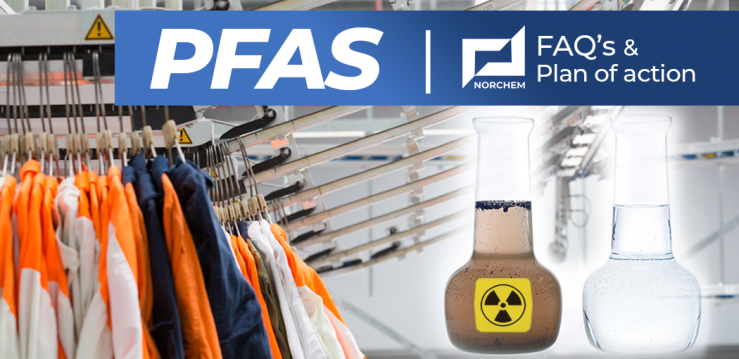PFAS - What you need to know
August 24, 2022

“PFAS” is short for per- and polyfluoroalkyl substances. Chemicals in this class of more than 5,000 substances are found in products across the industry like garments, uniforms, outdoor clothing and fabric stain-protective coatings.
General FAQ sheet - download here
FAQ's

Are any customers requesting assistance in removing PFAS compounds (or PFAS “precursors”) from their wastewater? If so, what are you recommending that they do?
We have had several current and potential customers reach out to start discussions on how to manage PFAS since the EPA’s Health Advisory on PFAS in drinking water was released on June 15th. We are recommending to first do a base line test to see what the actual levels are in the waste stream. Based on some current PFAS limits imposed in a few cities, the compliance limits will vary across the US. Knowing what the baseline PFAS levels are will help determine what may be required to remove the PFAS prior to discharge. Once we have base line data, we can help develop a solution to remove and dispose of the PFAS.
What do you see at the preferred technologies for removing PFAS? Reverse osmosis? Ultrafiltration? Nanofiltration? Ion Exchange Granular Activated Carbon or others?
We have done extensive testing with DAF, Ultrafiltration, RO, and Granular Activated Carbon (GAC), as well as a combination of these technologies, and found the best way remove PFAS is via Ultrafiltration followed by either RO or GAC systems.
What would you recommend to laundries as far disposing of PFAS substances once they’re removed from wastewater? Special landfills for hazardous materials?
PFAS will need to be managed as a hazardous waste once it is removed from the waste stream, which means laundries will no longer be able to easily dispose of sludge that has been removed from a DAF, Ultrafiltration, or RO system. The most common way to dispose of PFAS currently, is a hazardous waste landfill. Incineration processes are being evaluated to verify PFAS destruction. The disposal methods may be determined by type of waste generated, and geographic location. While there are limited methods to have PFAS disposed of, it is a very costly process. We are in the process of researching and developing different technologies to destroy PFAS on site to reduce or eliminate disposal cost for the laundry industry.
With the federal EPA and agencies in states such as California, Michigan and others tightening rules for PFAS in wastewater (possibly dropping this fall to 4 parts per quadrillion), what actions should laundries be looking at now to protect themselves from heightened regulations in the near term?
Start looking at supply chains to reduce the amount of PFAS washed out of the textiles. Test effluent wastewater to understand current PFAS baseline levels. Start looking at treatment systems to remove or reduce the PFAS levels in the effluent waste stream. The type of technology and amount of treatment that will be required will be determined by the PFAS limits set by each POTW.
